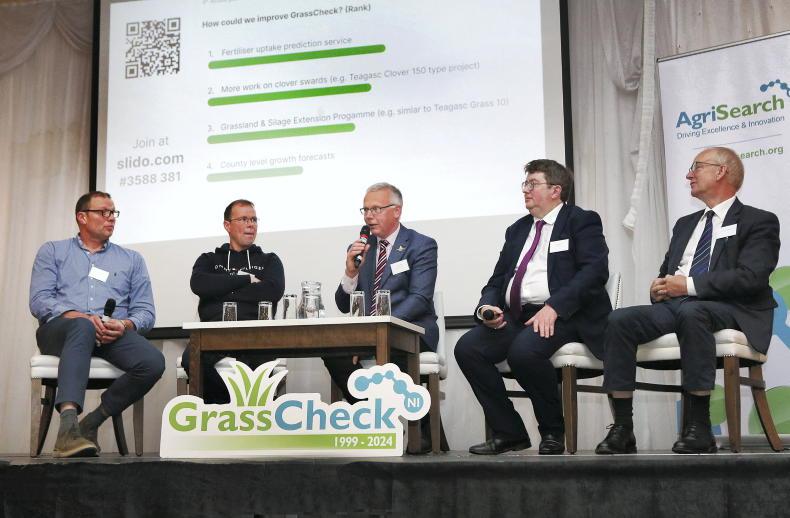A potential carbon tax on fertiliser and a general drive to cut usage due to concerns around nutrient loss to the environment, means clover has to become the base plant in every grazing sward, a researcher has said.
“If we didn’t have solutions, that would be a real problem. I can’t imagine any other future for a farmer than having clover in the sward,” Dr Brendan Horan from Teagasc told a conference on Tuesday, held to mark 25 years of the GrassCheck programme in NI.
During his presentation, Horan highlighted results from trials at both Ballyhaise College in Cavan and Moorepark in Co Cork. At Ballyhaise, grass clover swards with a limited chemical nitrogen (N) input of around 90kg N/ha are able to outperform perennial ryegrass only swards annually supplied with over 200kg of N/ha. Dry matter intakes and milk yields are also higher on the grass clover treatments.
In addition, work at Moorepark suggests a multispecies sward gives a further production benefit over a grass clover alternative.
“What’s not to like about having clover in our swards?” said Horan.
Practice
In practice, if there are new taxes or restrictions placed on fertiliser, farmers might simply opt to further rely on bought-in feedstuffs to cover for any forage deficit.
However, Horan argued that analysis since 2013 shows that the costs of growing grass and grass clover might be up, but alternative feeds are actually up more. “Alternatives to grass are increasingly unprofitable,” he suggested.
Making a similar point, former AFBI CEO Dr Sinclair Mayne warned that if less forage is grown in NI due to restrictions on fertiliser, it will lead to more imports of compound feed.
He said there is still a key role for fertiliser, especially in the spring and early summer, when grass clover swards can be slow to perform (as clearly evident in 2024).
Looking ahead, he said the GrassCheck programme can help farmers optimise when they apply fertiliser. One potential development is a weekly prediction showing the likely response to each kg of fertiliser applied.
The evolution of the GrassCheck programme
The origin of the GrassCheck programme goes back to 1998 when analysis of data showed the disparity of what could be grown on farms against what was actually being utilised in practice, confirmed Dr Sinclair Mayne.
He told Tuesday’s conference that experimental plots were capable of growing over 20t dry matter per hectare (DM/ha) and the best fields could grow 18t. However, the average NI dairy farm was only utilising 7.5t DM/ha, while beef and sheep farms averaged 4.1t DM/ha.
The following spring, Grass Check was launched, with growth measured on plots at Greenmount and AFBI sites at Hillsborough and Crossnacreevy. Initially, a very high nitrogen (N) rate of 360kg/ha was used, which was subsequently reduced to 270kg N/ha.
Between 2007 and 2012 a number of other sites were brought in from across NI. The cost proved to be “unsustainable” and only the plots at Greenmount and AFBI Hillsborough still remain.
Over the years from 1999 to 2016, the plots grew an average of 11.3t DM/ha, but with large variation across years from a low of 8.1t in 2002 to a high of 13.6t in 2016.
“That brings big challenges and has a huge impact on stocking rates on farms. The variation between years is much greater than I thought would happen at the beginning of the project,” said Mayne.
Phase 2
The second phase of Grass Check brought farmers on board, explained Jason Rankin from AgriSearch. Initially, 35 farmers were recruited in 2017 and there are now 53 inputting grass growth data each week through the growing season.
Analysis of data shows there is significant variation in annual growth between counties and also between farms in the same county, with the top farm in Tyrone able to grow over 6t more DM/ha than the bottom performer.
Comparing grass quality data from the four years to 2021 with results since 2022, highlights that energy and protein values in spring months on the GrassCheck farms have been significantly lower in recent years. It is something that is also being seen in poorer-quality first cuts across NI.
“We don’t fully understand why that is happening, as yet,” confirmed Rankin.
Volatile mid-season grass growth in NI
In the 10 years to 2020, average growth was better in the early season, the summer peak was later in the year and there was more variability between years, than in the previous 10-year period, confirmed Dr Taro Takahashi from AFBI.
He suggested that those trends could be an indicator of what is to come as a result of climate change.
Using predicted data from the Met Office for the year 2100, a grass growth forecasting model suggests NI will be growing over 2t more DM/ha than it is at present, taking the average to over 12t DM/ha.
Growth in 2100 is generally expected to be higher than it is now in March to May, as well as in October and November.
However, growth from June to August is likely to be much more volatile than at present, suggested Takahashi.






 This is a subscriber-only article
This is a subscriber-only article










SHARING OPTIONS: